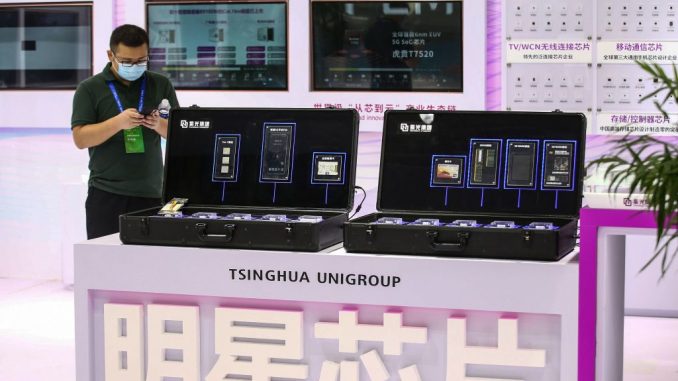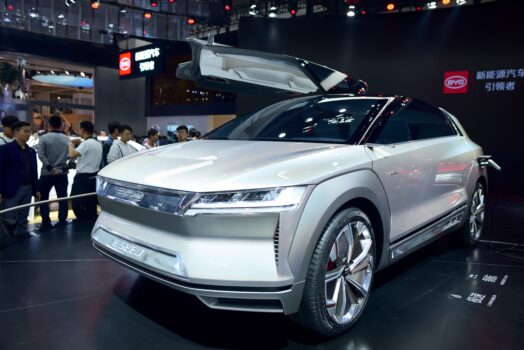
China’s industrial sector is suffering from a severe shortage of semiconductor chips, following U.S. sanctions and other supply problems, which is seriously slowing down the country’s manufacturing capacity. Recently, Tsinghua University announced the establishment of a new school that would help solve the country’s chip shortage problem, as Chinese leaders promote a Marxist approach to speed up chip production. But experts say China has a long way to go.
On April 22, Tsinghua University in Beijing announced the establishment of the School of Integrated Circuits that would help China build up its own chip market and cut its reliance on foreign suppliers. During the inauguration ceremony, Tsinghua’s president, Qiu Yong, said, “The skyscraper of a strong country cannot be built on the foundation of others. The key core technology must be in one’s own hands.”
Qiu also said that the school’s goal is to have its best scientists develop key core technologies; accelerate the cultivation of much-needed “high-level innovative talent”; provide strategic support for the development of technological “self-sufficiency and self-improvement.”
The announcement by Tsinghua came three days after Chinese leader Xi Jinping visited the university on April 19.
Chip Shortage Hits China’s Auto, Manufacturing Industries
Due to U.S. sanctions and the impact of the pandemic, China is suffering a severe shortage of semiconductor chips. Following Volkswagen and NIO, Chinese automaker Great Wall Motors is also experiencing a choke point. Its two main production bases in Chongqing and Baoding city are rumored to stop production in May and June, affecting popular models such as the Haval H6, Great Wall Cannon, and Tank 300. Great Wall Motors, however, denied the rumors in a public statement on April 24.
In December last year, FAW-Volkswagen and Shanghai Volkswagen were forced to suspend production at some of their plants due to chip shortages.
NIO’s plant in Hefei city, Anhui Province, was forced to stop production for five days from March 29 to April 2 this year. The lack of chips remains a serious problem, NIO co-founder and president Qin Lihong said during the recent Shanghai auto show.
Hozonauto’s president, Zhang Yong, also admitted that they had to give up some orders, involving 6,000 vehicles in the first quarter.

The China Association of Automobile Manufacturers predicted this month that the chip shortage will have a greater negative impact on China’s auto production in the second quarter than it had in the first.
The shortage of chips has had a huge impact on the Chinese manufacturing industry, with some companies seeking to buy chips at highly inflated costs. Quoting the former head of Samsung Electric, the Chinese semiconductor industry has been panic stockpiling, with some companies buying chips at prices up to 20 times the regular rate, from any source they are able to around the globe, First Financial reported on April 21.
Furthermore, impacted by the pandemic, the global chip supply has been increasingly tight since the second half of 2020, with automotive, cell phones, small home appliances, and other chip-related industries seriously affected.
China’s chip supply shortage is further exacerbated by recent events such as the Texas blizzard, a fire at Japan’s chipmaker Renesas Electronics, and drought in Taiwan.
Xi Advocates Marxist Approach to Handle Chip Problem
Faced with the situation of a dwindling chip supply, Xi Jinping has repeatedly stressed the need of taking control of this sector and that universities need to follow the CCP’s leadership.
When visiting Tsinghua University on April 19, Xi said the first-class universities need to adhere to the leadership of the CCP by following its educational policies and upholding its marxist and communist ideologies. He also called on Tsinghua students to “sense the urgency of the country,” to have the courage to undo the choke point of key core technologies, and to draw strength and inspiration from the “lessons of Party history,” according to a report by Xinhua.
On March 15, a month prior to his visit to Tsinghua University, Xi had penned an article titled, “Strive to Become the World’s Leading Scientific Center and a High Ground of Innovation,” which was published in the Communist Party’s theoretical journal Quishi (or Seeking Truth). It called for a major effort in key areas and “choke point” areas, gathering “elite forces,” and striving to realize the strategic change “from following to running ahead and leading.”
It Will Take Decades for China to Solve Chip Dilemma
A commentator who goes by the name “Hong He Cong” on Chinese social media Zhihu, criticized the Chinese regime’s handling of the chip shortage crisis, calling the CCP’s approach a “Great Leap Forward style chip-making campaign.” He pointed out that making chips involves more than 50 disciplines in science and technology and thousands of processes, and as of now, no country is able to make chips on their own.
The article quotes John Lee, a senior researcher at the Mercator Center for China Studies (MERICS), a German think tank, as saying that the chip production process is built on decades of knowledge accumulation in the West, and that it is unlikely that Chinese companies will be able to produce chips independently of the existing industry chain in the near future. Lee highlighted the need to use U.S. patented technology in the upstream of the semiconductor equipment supply chain.

In addition, dictatorships such as the CCP are subject to multilateral export controls imposed by the international community. This control dates back to 1949, when the U.S. established the Coordinating Committee for Multilateral Export Controls (CoCom) with 16 other countries, including the UK, Japan, and France. The United States further established a China committee in 1952, an executive agency dedicated to enforcing the embargo against the CCP.
After the dissolution of the CoCom in 1994, its list of embargoed items was succeeded by the Wassenaar Agreement, which was signed by 42 countries worldwide in 1996. The agreement once again added China to the list of controlled countries. Last December, the agreement expanded the scope of control to include military-grade semiconductor manufacturing technologies and photolithography.
All the major equipment suppliers in the global semiconductor industry have joined the agreement, so China basically does not have access to the most advanced equipment and technology. For example, SMIC’s official website shows that the 32nm lithography machine it purchased in 2015 was produced by ASML in 2010; while for the semiconductor industry, five years is enough time for TSMC to make multiple upgrades.
China expert and U.S.-based current affairs commentator Li Yanming, who has been following China’s chip supply situation, also believes that the CCP’s attempt to overtake the world in the chip field and solve the chip shortage problem will take several decades.
“Judging by the global trend of blocking the CCP, it is hard to say how long the CCP regime will last,” Li said.






Be the first to comment